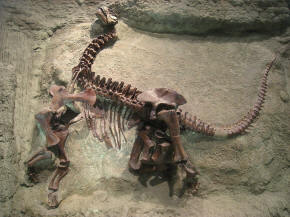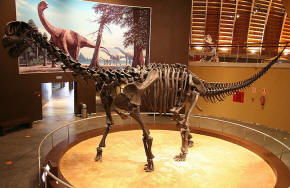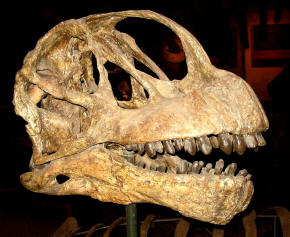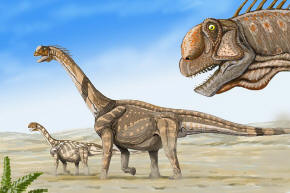|
Description
Camarasaurus
is among the most common and frequently well-preserved sauropod dinosaurs.
The maximum size of the most common species, C.
lentus, was about 15 meters (50 ft) in length.
The largest species, C. supremus,
reached a maximum length of 23 meters (75 ft).
The arched skull of
Camarasaurus was
remarkably square and the blunt snout had many fenestrae, though it
was sturdy and is frequently recovered in good condition by paleontologists.
The 19 centimeter long (7.5 in) teeth were shaped like
chisels (spatulate) and
arranged evenly along the jaw. The strength of the teeth indicates that
Camarasaurus
probably ate coarser plant material than the slender-toothed
diplodocids.
Each front limb bore five toes, with
the inner toe having a large sharpened claw. Like most
sauropods, the front limbs were shorter than the hind legs, but the high
position of the shoulders meant there
was little slope in the back.
Serving the purpose of
weight-saving, as seen in other sauropods, many of the vertebrae were
hollowed out or pneumatic,
riddled with passages and cavities for an intricate system of air sacs
connected to the lungs. This feature was relatively unknown at the time
Camarasaurus was
discovered, and was the inspiration for its name, meaning "chambered
lizard". The neck and counter-balancing tail were shorter than usual for a
sauropod of this size. Camarasaurus,
again like certain other sauropods, had an enlargement of the spinal cord near the
hips. Palaeontologists
originally believed this to be a second brain, perhaps
necessary to co-ordinate such a huge creature. However, while it would have
been an area of large nervous, probably reflex (automatic) activity, it was
not a brain, and such enlargements are actually found to some degree in all
vertebrate animals.
Camarasaurus lewisi
and
C. grandis both had
more robust radii than fellow sauropod
Venenosaurus.
History of
study
The first record of
Camarasaurus comes from
1877, when a few scattered vertebrae were located
in Colorado, by Oramel W.
Lucas. The paleontologist
Edward Drinker Cope
paid for the bones, as part of his long-running and acrimonious competition
with
Othniel Charles Marsh
(known as the
Bone Wars) and named
them in the same year. Marsh later named some of his sauropod findings
Morosaurus grandis
but most paleontologists today consider this to be a species of
Camarasaurus. Such naming
conflicts were common between the two rival dinosaur hunters, the most
famous being
Brontosaurus/Apatosaurus.
It was not until 1925 that a
complete skeleton of Camarasaurus
was recovered, by
Charles W. Gilmore.
However, it was the skeleton from a young
Camarasaurus, which is why so many illustrations
of the dinosaur from the time show it to be much smaller than it is now
known to be.
The Morrison Formation, along the
eastern flank of the Rocky Mountains, is
home to a
 |
| The first known complete skeleton, C. lentus |
rich stretch of Late Jurassic rock. A large number of dinosaur
species can be found here, including relatives of the
Camarasaurus such as
Diplodocus,
Apatosaurus and
Brachiosaurus.
However, camarasaurs are the most abundant of all the dinosaurs in the
Formation.There have been a number of complete skeletons recovered from
Colorado, New Mexico, Utah, and Wyoming. Present in
stratigraphic zones 2-6.
Paleobiology
Herding
There is a fossil record of two
adults and a 12.2 meter (40 ft) long juvenile that died together in the Late
Jurassic Period, approximately 150 million years ago (in north east Wyoming, USA, excavated by the
Division of Vertebrate Paleontology of the
University of Kansas Natural History Museum
and Biodiversity Center, during the 1997 and 1998 'field seasons'). It is
assumed that their bodies were washed to their final resting place, in
alluvial mud, by a river in spate. This suggests that
Camarasaurus traveled in
herds or, at least,
'family' groups. Also, recovered camarasaur eggs have been found in
lines, rather than in neatly arranged nests as with some
other dinosaurs, which appears to suggest that, like most sauropods,
Camarasaurus did not tend
its young.
Digestion
Previously, some scientists had
suggested that Camarasaurus
and other sauropods may have swallowed stones (gastroliths)
to help grind the food in the stomach and then regurgitated or passed them
when they became too smooth. However, more recent analysis of the evidence
for stomach stones has suggested that this was not the case. Furthermore,
the strong, robust teeth of Camarasaurus
in particular were more developed than those of most sauropods, indicating
that it may have processed food in its mouth to some degree before
swallowing.
Species
The type species of
Camarasaurus is Cope's
original species, C. supremus
(meaning "the biggest chambered lizard"), named in 1877. Other species since
discovered include C. grandis
("grand chambered lizard") in 1877, C. lentus
in 1889, and C. lewisi
(originally described as a the new genus
Cathetosaurus) in 1988.
C. supremus,
as its name suggests, is the largest known species of
Camarasaurus and one of
the most massive sauropods known from the late Jurassic
Morrison Formation.
Besides its huge size, it was nearly indistinguishable from
C. lentus.
C. supremus was not
typical of the genus as a whole, and is only known from the latest,
uppermost parts of the formation. C. grandis
and C. lentus were
both smaller and present in the earlier stages of the Morrison.
Stratigraphic evidence suggests that the chronological sequence of the
Camarasaurus
species aligned with their physical differences and describe an evolutionary
progression within the Morrison Formation. C.
grandis is the oldest known species, present in
the lowest rock layers of the Morrison. C.
lentus appeared later, and co-existed with
C. grandis for
several million years, possibly due to different ecological niches suggested
by differences in the spinal anatomy of the two species. At a later stage,
C. grandis
disappears from the rock record, leaving only
C. lentus, which then also disappeared at the
same time C. supremus
appears in the uppermost layers. This immediate succession of species, as
well as the very close similarity between the two, suggests that
C. supremus may have
evolved directly from C. lentus,
representing simply a larger, later-surviving population of animals.
Return to the
Old Earth Ministries Online Dinosaur
Curriculum homepage.

Shopping
Bay
State Replicas - Juvenile skull, tooth, claw
Black
Hills Institute - Skull, skull in matrix, tooth, claw, right dentary,
tibia
|



